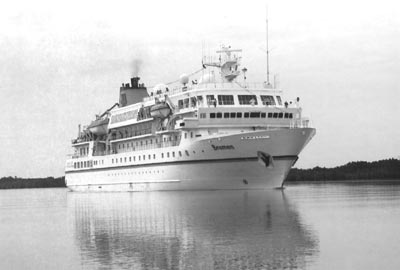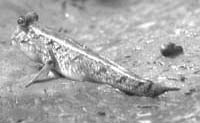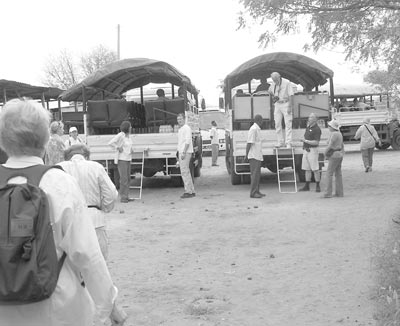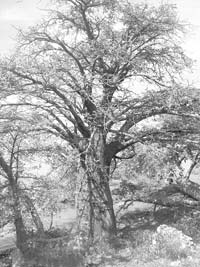Exploring West Africa in 4-star comfort
This item appears on page 84 of the April 2008 issue.
by Wayne Wirtanen (Part 2 of 3 on The Gambia and the Cape Verde Islands, jump to part 1, part 2, part 3)
Mudskippers
You’ve heard the expression “like a fish out of water.” Well, I was astonished to see hundreds of examples of “fish out of water” — mudskippers — on the muddy banks of a tributary of the Gambia River last year.
Would you believe that this fish (a goby) lives on land, would drown if held under water, is the only fish with movable eyelids, walks and hops on land, climbs trees and dives into the water only when threatened by a creature larger than itself?
Many species of mudskippers live in tropical, brackish (tidal, partly salty) water in Africa and the Far East. The ones that inhabit the muddy banks of tributaries of the Gambia River are only a few inches long but are aggressive predators on land and live in burrows alongside their predator buddies, small fiddler crabs.
My Internet research, after I arrived at home, revealed that although they are relatively rare as aquarium pets, mudskippers have enthusiastic fans because they are such a unique fish and can be fed by hand.
Their bulbous eyes, on the sides of their heads, give them each a 360-degree visual field. A mudskipper was certainly the inspiration for the cartoon figures that you’ve seen representing the evolutionary moment when a sea creature first crawled out of the water onto land. They may or may not be a missing link between sea creatures and land animals, but the thought is unavoidable.
The Gambia
The Gambia is Africa’s smallest country, maybe 400 miles long and also skinny, straddling the Gambia River for up to 15 miles on each side. (A small private plane would take about 10 minutes to fly across The Gambia at its narrow areas.)
There’s an apocryphal story, probably not true but fun to tell, about the establishment of The Gambia’s borders. When the British, during sailing-ship days, wanted to set boundaries for a country along the river, they fired a ship’s cannons in both directions perpendicular to the river, and where the cannon balls fell, that’s where the boundaries were drawn.
The Gambia’s official name always includes the word “The.” The reason for this has eluded my research.
Our expedition ship
The ship MS Bremen of Hapag-Lloyd Cruises (631 Commack Rd., Ste. 1A, Commack, NY 11725; 877/445-7447 or 631/858-1252, www.hl-cruises.com) was purpose-built for the increasingly popular expedition cruises to unusual destinations. I was privileged to be their guest in late October 2007.
The ship’s relatively shallow draft allowed us to go a good distance up the infrequently traveled Gambia River. With the extra range provided by the heavy-duty Zodiacs, we got a better look at the river than has been possible before in such 4-star comfort. (Among the ship’s itineraries are trips to Antarctica and a unique around-the-world cruise.)
The Bremen’s staterooms are of generous size, there’s a small swimming pool aboard, and the meals are at gourmet level with service to match. I was one of about 100 mostly senior adventurers — some 90 Germans and 10 Americans — and I was told that the crew on this trip totaled 100!
My Scandinavian DNA had me breakfasting on herring and smoked salmon. When most passengers chose more elaborate lunches, I frequently opted for a tender Argentine steak and French fries from the grill.
After a memorable dinner one evening at the end of the trip, the dining room lights suddenly dimmed. A parade of waiters circled the room with trays held high. . . with baked Alaska for dessert, the brilliant sparklers on the cakes illuminating the room! (Apparently, this is a European cruise tradition.)
All of the crew were bilingual, and we Americans had English-speaking guides on all of the excursions. Some programs were repeated in German and English, and on those special occasions where the whole group was together, translations were provided.
It was a pleasant surprise to find out how many of the German passengers spoke at least enough English to allow simple conversations along the way.
Day excursions
The Bremen was too large to dock at any riverside destination, so it would anchor midstream, with Zodiacs used nearly daily to transport us to jumping-off points. A variety of day trips was offered.
An expedition-truck/hiking safari to Kiang-West National Park, one of the largest protected areas in The Gambia, provided glimpses of the naturally occurring plants and the local terrain (flat).
Our visit was at the end of the rainy season and the vegetation was lush. (The trip was obviously scheduled for the great weather and lack of mosquitoes or any other nuisance insects.)
This was my first experience hiking in 10-foot-tall elephant grass, which was coarse, thick and sharp-edged. It was easy to see how difficult it would be to hike through these areas without well-worn trails.
Although this area is known for a very large population of African mammals and birds, we saw only a small number of birds and no mammals at all. We did, however, hear some baboons trumpeting in the near distance, probably complaining of our encroachment on their territory.
Crocodiles
One high point among the day trips was a visit to the holy crocodile park of Katchikally. Contact with the mossy waters in the pond there is believed to enhance fertility in the local ladies. I noticed a modest concrete shower stall near the pond for this purpose.
Very large crocodiles slumber in the sun, out of the water along the main park trail, inches from the feet of visitors. Signs warn against disturbing them — as if this advice were necessary.
Attendants, however, encouraged travelers to stroke the back of one or two of these large trailside crocs that were “tame enough” to allow this. It was a photo opportunity that I chose to forgo.
Baobab trees
The giant baobab tree, common throughout The Gambia, is the country’s national symbol. It is called the “upside down tree” because the pattern of branches resembles a tree’s root system sticking up into the air. It grows well in the thick alluvial soil along the Gambia River.
On one of our excursions, we drove by a large number of pelicans roosting in baobab trees. It inspired me to invent an Africanized verse of a popular Christmas song. Instead of “a partridge in a pear tree,” it would be sung, “. . . and a pelican in a baobab tree.”
An orphanage
We paid a visit to an SOS Children’s Village, which demonstrated that a non-governmental organization can organize an effective orphanage/school for children. Their programs provide shelter and family-based care for more than 60,000 children in 123 countries around the world, including the USA.
Typically, 10 children live with a permanent surrogate “mother” in their own separate house. Between 10 and 40 of these houses form an independent “village.” Family groups once formed are kept together while the children mature.
For information on these villages, contact SOS Children’s Villages-USA (1200 D. St. NW, Ste. 550, Washington, D.C. 20005; 888/505-KIDS or 202/347-7920, www.sos-childrensvillage.org). One can sponsor a child or a village for only $28 a month.
Next month I’ll report on the volcanic Cape Verde Islands. Happy trails!




